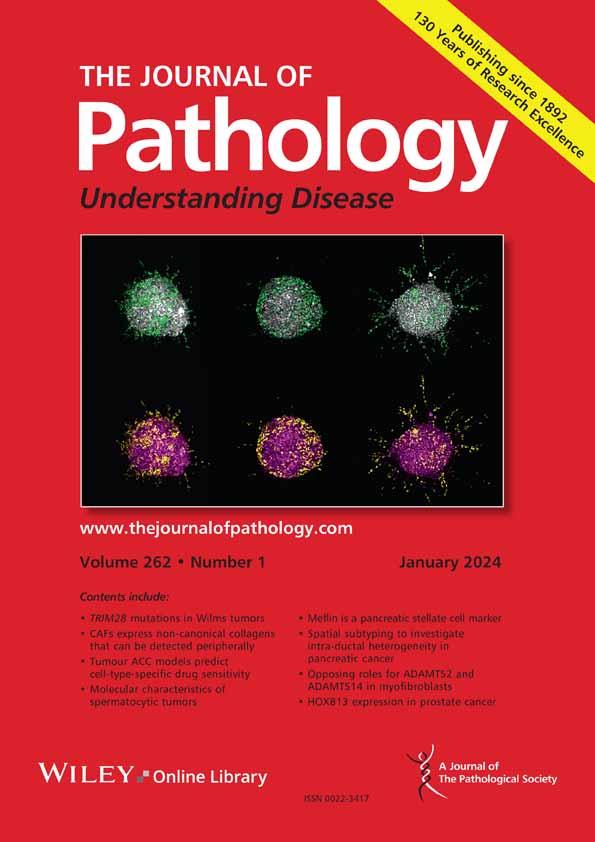A Tc1- and Th1-T-lymphocyte-rich tumor microenvironment is a hallmark of MSI colorectal cancer
IF 5.2
2区 医学
Q1 ONCOLOGY
Zhihao Huang, Tim Mandelkow, Nicolaus F Debatin, Magalie C J Lurati, Julia Ebner, Jonas B Raedler, Elena Bady, Jan H Müller, Ronald Simon, Eik Vettorazzi, Anne Menz, Katharina Möller, Natalia Gorbokon, Guido Sauter, Maximilian Lennartz, Andreas M Luebke, Doris Höflmayer, Till Krech, Patrick Lebok, Christoph Fraune, Andrea Hinsch, Frank Jacobsen, Andreas H Marx, Stefan Steurer, Sarah Minner, David Dum, Sören Weidemann, Christian Bernreuther, Till S Clauditz, Eike Burandt, Niclas C Blessin
下载PDF
{"title":"A Tc1- and Th1-T-lymphocyte-rich tumor microenvironment is a hallmark of MSI colorectal cancer","authors":"Zhihao Huang, Tim Mandelkow, Nicolaus F Debatin, Magalie C J Lurati, Julia Ebner, Jonas B Raedler, Elena Bady, Jan H Müller, Ronald Simon, Eik Vettorazzi, Anne Menz, Katharina Möller, Natalia Gorbokon, Guido Sauter, Maximilian Lennartz, Andreas M Luebke, Doris Höflmayer, Till Krech, Patrick Lebok, Christoph Fraune, Andrea Hinsch, Frank Jacobsen, Andreas H Marx, Stefan Steurer, Sarah Minner, David Dum, Sören Weidemann, Christian Bernreuther, Till S Clauditz, Eike Burandt, Niclas C Blessin","doi":"10.1002/path.6415","DOIUrl":null,"url":null,"abstract":"<p>Microsatellite instability is a strong predictor of response to immune checkpoint therapy and patient outcome in colorectal cancer. Although enrichment of distinct T-cell subpopulations has been determined to impact the response to immune checkpoint therapy and patient outcome, little is known about the underlying changes in the composition of the immune tumor microenvironment. To assess the density, composition, degree of functional marker expression, and spatial interplay of T-cell subpopulations, 79 microsatellite instable (MSI) and 1,045 microsatellite stable (MSS) colorectal cancers were analyzed. A tissue microarray and large sections were stained with 19 antibodies directed against T cells, antigen-presenting cells, functional markers, and structural proteins using our BLEACH&STAIN multiplex-fluorescence immunohistochemistry approach. A deep learning-based framework comprising >20 different convolutional neuronal networks was developed for image analysis. The composition of Type 1 (T-bet<sup>+</sup>), Type 2 (GATA3<sup>+</sup>), Type 17 (RORγT<sup>+</sup>), NKT-like (CD56<sup>+</sup>), regulatory (FOXP3<sup>+</sup>), follicular (BCL6<sup>+</sup>), and cytotoxic (CD3<sup>+</sup>CD8<sup>+</sup>) or helper (CD3<sup>+</sup>CD4<sup>+</sup>) T cells showed marked differences between MSI and MSS patients. For instance, the fraction of Tc1 and Th1 was significantly higher (<i>p</i> < 0.001 each), while the fraction of Tregs, Th2, and Th17 T cells was significantly lower (<i>p</i> < 0.05) in MSI compared to MSS patients. The degree of TIM3, CTLA-4, and PD-1 expression on most T-cell subpopulations was significantly higher in MSI compared to MSS patients (<i>p</i> < 0.05 each). Spatial analysis revealed increased interactions between Th1, Tc1, and dendritic cells in MSI patients, while in MSS patients the strongest interactions were found between Tregs, Th17, Th2, and dendritic cells. The additional analysis of 12 large sections revealed a divergent immune composition at the invasive margin. In summary, this study identified a higher fraction of Tc1 and Th1 T cells accompanied by a paucity of regulatory T-cell, Th17, and Th2 T-cell subpopulations, along with a distinct interaction profile, as a hallmark of MSI compared to MSS colorectal cancers. © 2025 The Author(s). <i>The Journal of Pathology</i> published by John Wiley & Sons Ltd on behalf of The Pathological Society of Great Britain and Ireland.</p>","PeriodicalId":232,"journal":{"name":"The Journal of Pathology","volume":"266 2","pages":"192-203"},"PeriodicalIF":5.2000,"publicationDate":"2025-04-03","publicationTypes":"Journal Article","fieldsOfStudy":null,"isOpenAccess":false,"openAccessPdf":"https://onlinelibrary.wiley.com/doi/epdf/10.1002/path.6415","citationCount":"0","resultStr":null,"platform":"Semanticscholar","paperid":null,"PeriodicalName":"The Journal of Pathology","FirstCategoryId":"3","ListUrlMain":"https://pathsocjournals.onlinelibrary.wiley.com/doi/10.1002/path.6415","RegionNum":2,"RegionCategory":"医学","ArticlePicture":[],"TitleCN":null,"AbstractTextCN":null,"PMCID":null,"EPubDate":"","PubModel":"","JCR":"Q1","JCRName":"ONCOLOGY","Score":null,"Total":0}
引用次数: 0
引用
批量引用
Abstract
Microsatellite instability is a strong predictor of response to immune checkpoint therapy and patient outcome in colorectal cancer. Although enrichment of distinct T-cell subpopulations has been determined to impact the response to immune checkpoint therapy and patient outcome, little is known about the underlying changes in the composition of the immune tumor microenvironment. To assess the density, composition, degree of functional marker expression, and spatial interplay of T-cell subpopulations, 79 microsatellite instable (MSI) and 1,045 microsatellite stable (MSS) colorectal cancers were analyzed. A tissue microarray and large sections were stained with 19 antibodies directed against T cells, antigen-presenting cells, functional markers, and structural proteins using our BLEACH&STAIN multiplex-fluorescence immunohistochemistry approach. A deep learning-based framework comprising >20 different convolutional neuronal networks was developed for image analysis. The composition of Type 1 (T-bet+ ), Type 2 (GATA3+ ), Type 17 (RORγT+ ), NKT-like (CD56+ ), regulatory (FOXP3+ ), follicular (BCL6+ ), and cytotoxic (CD3+ CD8+ ) or helper (CD3+ CD4+ ) T cells showed marked differences between MSI and MSS patients. For instance, the fraction of Tc1 and Th1 was significantly higher (p < 0.001 each), while the fraction of Tregs, Th2, and Th17 T cells was significantly lower (p < 0.05) in MSI compared to MSS patients. The degree of TIM3, CTLA-4, and PD-1 expression on most T-cell subpopulations was significantly higher in MSI compared to MSS patients (p < 0.05 each). Spatial analysis revealed increased interactions between Th1, Tc1, and dendritic cells in MSI patients, while in MSS patients the strongest interactions were found between Tregs, Th17, Th2, and dendritic cells. The additional analysis of 12 large sections revealed a divergent immune composition at the invasive margin. In summary, this study identified a higher fraction of Tc1 and Th1 T cells accompanied by a paucity of regulatory T-cell, Th17, and Th2 T-cell subpopulations, along with a distinct interaction profile, as a hallmark of MSI compared to MSS colorectal cancers. © 2025 The Author(s). The Journal of Pathology published by John Wiley & Sons Ltd on behalf of The Pathological Society of Great Britain and Ireland.
富含Tc1和th1 - t淋巴细胞的肿瘤微环境是MSI结直肠癌的标志。
微卫星不稳定性是结直肠癌患者对免疫检查点治疗反应和预后的一个强有力的预测指标。尽管已确定不同t细胞亚群的富集会影响对免疫检查点治疗的反应和患者的预后,但对免疫肿瘤微环境组成的潜在变化知之甚少。为了评估t细胞亚群的密度、组成、功能标记表达程度和空间相互作用,我们分析了79例微卫星不稳定型(MSI)和1045例微卫星稳定型(MSS)结直肠癌。使用我们的BLEACH&STAIN多重荧光免疫组织化学方法,用19种针对T细胞、抗原呈递细胞、功能标记和结构蛋白的抗体对组织微阵列和大切片进行染色。基于深度学习的框架包括bbbb20个不同的卷积神经网络,用于图像分析。1型(T-bet+)、2型(GATA3+)、17型(RORγT+)、nkt样(CD56+)、调节性(FOXP3+)、滤泡性(BCL6+)、细胞毒性(CD3+CD8+)或辅助(CD3+CD4+) T细胞的组成在MSI和MSS患者之间存在显著差异。例如,Tc1和Th1的分数显著高于(p
本文章由计算机程序翻译,如有差异,请以英文原文为准。







 求助内容:
求助内容: 应助结果提醒方式:
应助结果提醒方式:


